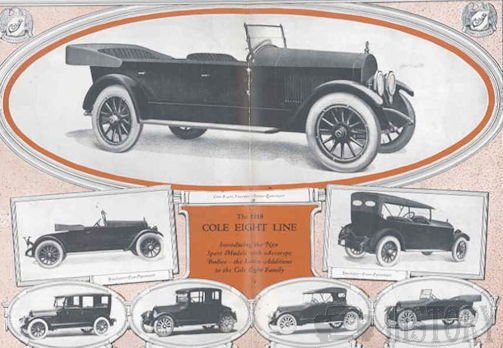Cole 8 Series Cars
| Cole V8 Series Cars from 1915 to 1925 | |
|---|---|
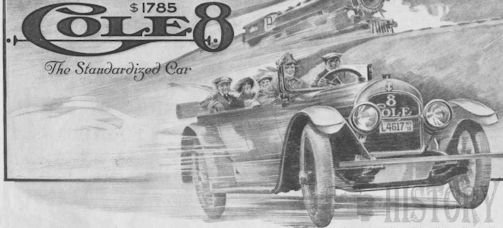 |
|
| Manufacturer | Cole |
| Production | 1915-1925 |
| Assembly | USA |
| Body and chassis | |
| Body style | Torpedo,Touring ,Sedan |
| Layout | FR layout |
| Powertrain | |
| Engine | V8 |
| Transmission | 4-speed and reverse |
| Dimensions | |
| Wheelbase | 127" |
The Cole Motor Car Company was an early automobile maker based in Indianapolis, Indiana. The Cole Models 40 50 were built from 1912 until 1912.
The Cole V-8
Big news came in mid-1915: Only one year after Cadillac had pioneered the V-8 engine, and about at the same time as the mighty Cunningham V-8 debuted, Cole brought out its own V-8 powered automobile - and would stay with it until the very end of the make, dropping its Fours and Sixes after 1916.
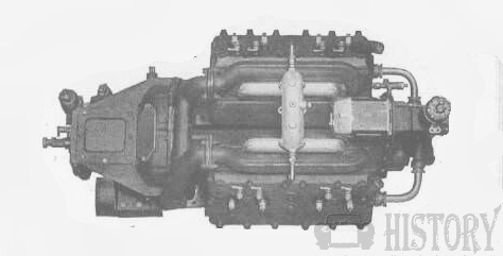
Cole V8 engine
This engine had a displacement of 346.3 c.i. and delivered 39.2 HP. It was built by Northway, then a division of General Motors that also manufactured the V-8 for Cadillac. The car was named the Model 8-50. It had a 127-inch (3,200 mm) wheelbase. Five body styles were available at prices between $1,785 and $3,250. Targeted at this level were, of course, Cadillac; Stearns-Knight, who came out with a sleeve-valve V-8 in 1916; or Lozier who drastically reduced its prices to about this level for its last season of existence.
Positioned higher were, among others, the Mercer, the McFarlan, and the Packard, with prices starting at about $3,000; or the Kissel with three full lines of 4- and 6-cylinder cars that were only slightly less expensive.
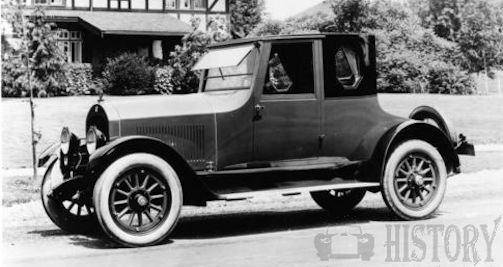
1920 Cole Aero Eight 3 passenger
There were few changes for 1917. The car was now called the Model 860. There were five body styles at about the same price level. Some of them received quite flamboyant designations such as "Tuxedo Roadster", "Tourcoupe", and "Toursedan", of which a "Foredoor Toursedan" existed. 4193 Cole automobiles were manufactured in that year.
The new kind of marketing became even more apparent in 1918. Advertising slogans were "There's a Touch of Tomorrow In All Cole Does Today" or "Did You Ever Go Ballooning in a Cole?", the latter referring to the adoption of balloon tires as an option that year (they became a standard feature finally in 1925). The car was advertised as the "Aero-Eight" (internally Model 870). There were only three body styles left, a roadster, a "Sportster" and the obligatory touring car. They cost $2,395 each and seated 2, 4, and 7 passengers, respectively . The cars also became more fashionably styled.
The 870 Aero-Eight was technically much the same in 1919 but there were now seven bodies to choose from at prices between $2,595 and $3,795 for the new town car and the "Tourcoupe". Some closed bodies got an octagonal rear quarter window as a "beauty" feature. That year, 6,225 Coles were built.
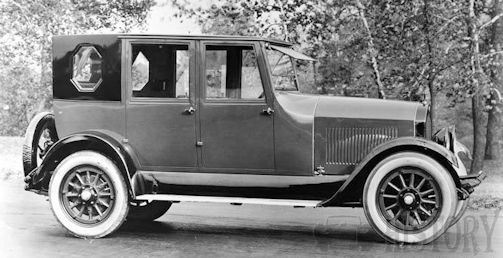
1920 Cole Aero Eight 5 passenger
The "Aero-Eight" Model 880 for 1920 was boldly announced: "The Forecast of Future Fashions". The ad further bragged that there were 15,000 miles (24,000 km) possible on its tires. Available were only three body styles, all of them of an open type: A Roadster for 2 and a Speedster for 4 passengers at $2,750 plus a "Tourster" a.k.a. touring car for $2,850. But naming the product got even more creative. While "Sportsedan" and "Sportcoupe" might sound familiar in our ears, "Sportosine" and "Tourosine" for some closed cars definitely do not. These cars got adjustable, "storm-proofed" windshields that had an angled position. Cole switched to Johnson carburettors and introduced a one-piece rear axle and a brake adjuster. The gear ratio was 4.45 (until 1922). A new measure for power replaced the antiquated N.A.C.C. rating. Thus, the Cole V-8 came in with 80 bhp (60 kW) and stayed there until car production ceased. Prices were slightly up and were between $2,750 and $3995.
1921 Coles were only slightly altered. Most of the exalted terms vanished - but "Sportosine" and "Tourosine" remained. There were 8 body styles that were substantially more expensive: $3,250 for the three open cars and between $4,250 and $4,450 for closed.
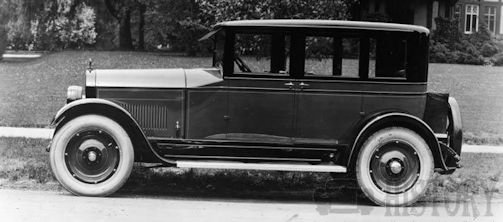
Late 1925 Cole sedan
Facing the end
Cole opened new, wider production facilities in 1922. However, sales went down rapidly, mainly because of a short but severe recession. Although there were more models to choose from and prices were reduced drastically (most to a level under that of 1918 / 1919), only 1,722 cars were built of the Model Aero Eight 890, as the car was called that year. The wheelbase was increased by a quarter inch, and the frame ends were split. The Sportcoupe had a weight of 4,155 pounds (1,885 kg). The car was priced at $3,385 with a 75 mph (121 km/h) speedometer.
Innovations in 1923 for the Series 890 Cole were stylish drum-type headlights, cowl ventilation, and a new windshield with an adjustable upper half on open cars. Other elegant details were wire wheels instead of the previously used "artillery wheels" with fashionable disc wheels on the option list. For this year only, some cars had an added sporty touch with runningboards that did not span the whole length, leaving the chassis-mounted spare wheels "free". Still, with eight types of bodies, prices for open cars were slightly up while those for closed cars remained the same. The most expensive 1922 model, the $4,185 "Tourosine", was gone as were all those strange names, with the exception of the "Sportsedan". Only 1,522 cars left the factory that year.
In this situation and without any debts yet, J. J. Cole decided to liquidate his company rather than risking his fortune by going on. So, it is no wonder that the Model 890, now also called "Master" series, went little changed on the show room floors. Full-length running boards were back on all models. There were seven body styles, again sharply reduced to prices as low as $2,175 for open bodies, $2,750 for a coupe and $3,075 for other closed cars. A Cole was honored to pace that year's Indy 500 race.
Before the curtain finally fell, there were five cars available for 1925. Balloon tires (34" × 7.3") were now standard equipment, and the cars got new two-piece rear bumpers, so-called "bumperettes". Although Joseph Cole began liquidating his firm early in 1925, 607 cars left the factory. He died suddenly of an infection on August 8, 1925, shortly before liquidation was finished.
1916 Cole Eight range
